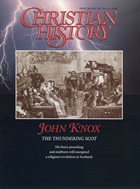With this article, Christian History begins a new feature that shows how the Christian faith has affected, and been affected by, recent events.
This year many people are remembering, and debating, the dropping of atomic bombs on Hiroshima and Nagasaki 50 years ago. In the following piece, historian Richard Pierard takes a personal look at the beginning of the atomic era and Christians’ involvement in it.
In early 1944, I was a few months shy of 10 years old when my father took a defense job at the Hanford Engineer Works (HEW) in Washington State. This was part of something known as the Manhattan Engineer District, an enterprise of the U.S. Army Corps of Engineers.
Having never ventured much more than 250 miles from Chicago, I could not conceive such a distance. The journey in an aging car that towed a tiny house trailer seemed like a pioneer odyssey. The wartime conditions imposed a maximum 35 miles per hour speed limit and gasoline rationing; our poor quality tires and frequent breakdowns added to the adventure.
Eventually we reached our destination, an arid, bleak, windswept place in the Columbia River Valley of eastern Washington. The foliage was sagebrush and dry range grass, the wildlife was jackrabbits and coyotes, and sandstorms were a regular feature. After being ordered to turn over cameras, binoculars, and two-way radios, we passed through a guarded fence and drove several miles until we arrived at Hanford, a sprawling construction camp.
From there nearly 50,000 people went out daily to labor at various sites in the surrounding region, where they built mysterious factories with meaningless names and no clear purpose. The workers were instructed simply to follow the blueprints, do what they were told, ask no questions, and discuss their jobs with nobody.
When autumn set in, the plant was completed and put into operation. Those who continued working on the project (like my father) were relocated in Richland, a government town that had been under construction since mid-1943. It lay at the edge of the 600-square mile reservation that had been sealed off from the outside world.
Shrouded in Secrecy
The 13,000 residents of Richland hailed from all around the United States, and they quickly formed a unique community of active, outgoing, generous, neighborly, and optimistic people. The populace was well-educated and relatively young; kinship ties were virtually nonexistent; birthrates were high; a premium was placed on family life, and voluntary societies flourished.
Single employees lived in apartment-style dormitories, and married couples in look-alike houses located on streets named after army engineers. All the amenities of life were available—a hospital, stores, banks, filling stations, cinemas, sports and recreation facilities.
We even had army-style churches, one for the Catholics and one for the Protestants. In the American spirit of pluralism, other communions who wished to hold services were permitted to rent space in schoolhouses.
For the most part, Christian faith and unquestioned patriotism went hand-in-hand to church on Sunday and to work on Monday. No one, not even the church, could foresee any moral problems or human tragedy on the horizon.
People traveled by bus to their jobs in the “areas”—three reactor and two separation complexes, which were from 35 to 50 miles from Richland. Naturally, they were forbidden to talk about what they were doing. They only knew they were helping to win the war. In fact, they were manufacturing plutonium, the primary component of nuclear weapons.
Everything was shrouded in secrecy. The plants had code names, and workers were not allowed to keep diaries or private notes. Hanford Works even had its own legal system so that information would not get out in open court proceedings. Press coverage was tightly regulated, and censors sought to prevent the publication of all news about the place. Only around two dozen people were authorized to know what was being made in the mysterious buildings that lay along the Columbia River and in the desert. However, my father, who was an accountant and office manager, told me that he had figured out what it was.
Winning the War
Then the veil of secrecy was lifted—at least partially—with the announcement of the dropping of the bomb on Hiroshima on August 6, 1945. I still remember the rejoicing that hot summer evening over the revelation that our plant was making the secret weapon that might end the war. After the second bomb was released over Nagasaki three days later, I remember trying to calculate how many bombs it would take to reduce the Japanese islands to utter nothingness.
Suddenly, the little “atom town” was the object of worldwide attention, and pride in the atomic bomb became Richland’s hallmark. The headline of the August 14 The Villager, the community’s weekly newspaper, screamed, Peace! Our Bomb Clinched It! Japs Surrender. The editor, N. Paul Nissen, expressed his joy that “Hanford’s own Atomic Bomb had been dropped” on the enemy and now the war was over.
A reporter solicited comments from various citizens. All believed that Hanford would continue to produce atomic materials. One friend of my father said, “Drop a bomb on the Emperor and let Richland get on with its work.” Another resident declared, “The only way to control the atomic bomb, and with it the peace in the world, is to continue making it and have enough on hand so that no one else in the world will want to fight us.”
The details of plutonium manufacturing at the Hanford Works remained shrouded in secrecy for years. Employees were required to have high-level security clearances, intensive monitoring of radiation exposure was a daily fact of life, and FBI agents frequently inquired about the loyalty and questionable habits of one’s neighbors.
“Nuke ’em”
After the war, though, other parts of the country began having doubts about nuclear weapons, Richland citizens remained enthusiastic about their work. In 1947 it touted itself as “The Atom-Bustin’ Village of the West” and the following year renamed its annual community festival “Atomic Frontier Days.”
Richland’s Columbia High School changed the name of its sports teams from the “Beavers” to the “Bombers.” When I was a student there in the late forties and early fifties, our cheerleaders wore a bomb symbol on their sweaters, and we did dive-bomber cheers.
As late as 1972, the students informally adopted a new school logo: a mushroom cloud. Although only the football players adopted it at first, the cloud symbol (sometimes with the phrase Nuke ’em) quickly spread throughout the school. It adorned notebooks, bumper stickers, tee-shirts, jackets, team uniforms, and even the tile floor in the foyer of the school gymnasium.
Such was the environment I grew up in. We gloried in the atomic bomb, and I worked for construction companies that were building new atomic plants on the Hanford site. One church, now called the Central United Protestant Church, adopted as its motto, “Where the atom is split, the churches unite.” The church to which I belonged believed fervently in American nationalism and Cold War anticommunism and never questioned our city’s main industry. All that was to change in the 1980s.
Stunning Revelations
Popular illusions suffered a crushing blow when the Department of Energy in 1986 began declassifying documents having to do with radiation leaks. It was discovered that the Hanford area contained the largest collection of nuclear waste in the entire Western world.
The public was stunned by such revelations as Operation Green Run: a 1949 radiological warfare experiment in which vast quantities of radioactive iodine (I-131) were released; one monitoring station in Kennewick reported an I-131 level almost 1,000 times more than the tolerable limit.
Other problems documented included the poisoning of fish in the Columbia River, contamination of drinking water both in Hanford and communities downstream, leaking storage tanks that contained highly radioactive liquids, and an abnormal incidence of thyroid cancer in areas downwind.
One writer vividly describes the pain: “In this region, known for its patriotism and support of government programs, the news just plain hurt.… Other areas of the Northwest began to treat the neighborhood surrounding Hanford as a pariah. A mantle of collective historical guilt was laid over [the area], as if residents were somehow to blame for the situation they had just discovered.
“In the ‘atomic city’ of Richland, many people instinctively defended their homes and their heritage. Some people denied the documents could be accurate. Perhaps a majority were bitter that the achievements of the Hanford complex as the workhorse of the nation’s defense effort now were being devalued.”
Accelerating a process already begun, the aging reactors were shut down one by one. However, the amount of waste at the Hanford site was so gigantic that the federal and state governments in 1989 agreed to a 30-year cleanup program that would require the investment of billions of dollars.
Lesser-Known Victims
A key event in my own life was a journey to Hiroshima I took in April 1956. I was serving with the U.S. Army in Japan, and I was curious to see the city where the first bomb had fallen. The ruins were still evident; a monument to the dead was located at Ground Zero, and a recently constructed museum featured a display of the bombing. I was utterly devastated.
This year we are debating the dilemmas and tragedies that the atomic bomb has created in Japan. We might also remember what happened to the people of Hanford and Richland, especially the many Christians. Their faith, hard work, and loyalty helped them build the first bombs. But for their unquestioning faith they have paid an awful price.
As a young Christian, though, I remember it all seemed so innocent and good.
Richard Pierard is professor of history at Indiana State University. He is co-author of the church history overview, Two Kingdoms: The Church and Culture through the Ages (Moody, 1993).
Copyright © 1995 by the author or Christianity Today/Christian History magazine.
Click here for reprint information on Christian History.

Support Our Work
Subscribe to CT for less than $4.25/month





























